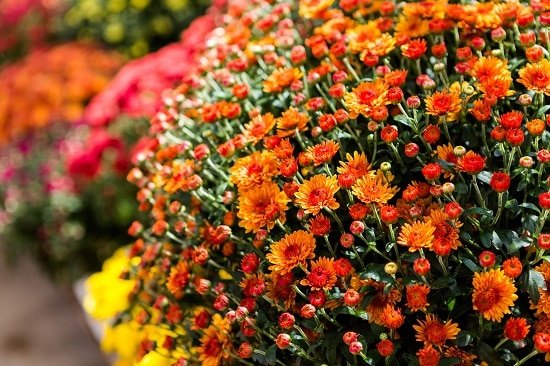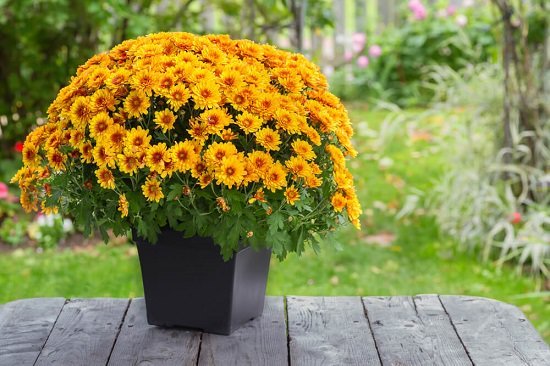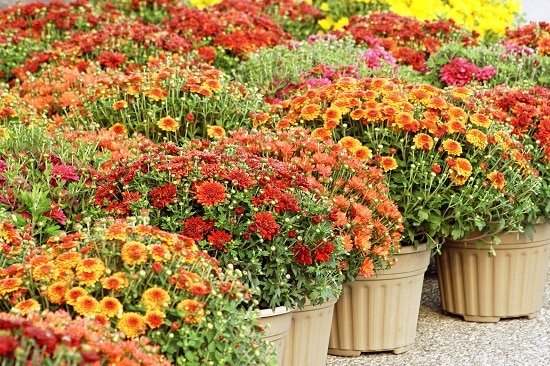Learn How to Grow Mums as Perennials with our easy-to-follow guide. Find out the best ways to care for these flowers all year round!
You are not alone if you are unsure about How to Grow Mums as Perennials. Many out there don’t understand the difference between Annual vs. Perennial Mums, and this is where we step in to clear all the doubts!
Annual vs. Perennial Plants
Annuals are short-living plants that flower and die in one season. They live an entire life cycle from seed to flower in a single growing season.
- Live for one growing season.
- Grow, flower, and produce seeds within one year.
- Require replanting each spring.
Perennials sustain for many growing seasons. The top part of many perennials die back every winter in cold climates and grow again in spring from the same root system.
- Live for multiple growing seasons, often for many years.
- Usually, they go dormant in the winter and return in the spring.
- Continue to grow without replanting.
Note: Depending on the growing conditions and local climate, a plant can be annual or perennial.
Chrysanthemum Flower Meaning and Symbolism
Are Mums Perennials or Annuals?
Chrysanthemums or mums are tender perennials that are often grown as annuals. In colder climates, they appear as annuals because they may not survive the harsh winter conditions.
However, under the proper care and in milder regions, Mums are true perennials. They go dormant during winter and return in the spring, showcasing their vibrant blooms year after year.
Note: Planting mums in spring helps build a healthy root system; this way, they can overwinter.
Can you Grow Mums as Perennials?
Yes! You can grow mums as perennials! Plant winter-hardy varieties in the spring instead of late summer or fall. As mums have a shallow root system, this measure will allow their delicate roots to establish well enough.
If you want to sparkle your late-season garden with the pretty fall colors of mums, plant them in late summer or early fall and handle them as annuals.
If you live in a hot, frost-free climate, i.e., USDA Zones 10-11, plant heat-tolerant mums in fall or winter. They will continue to grow well till spring, but to save them in summer, grow them in part sun and save them from harsh afternoon sunlight. Remember to water well to keep the soil moist.
Keep the following points in mind while growing mums as perennials:
- Plant in Well-Drained Soil: Ensure your Mums are planted in well-draining soil to prevent root rot. They prefer slightly acidic to neutral soil.
- Sunlight Requirements: Mums thrive in full sun. Choose a location that receives at least 5-6 hours of direct sunlight daily.
- Proper Watering: Avoid overwatering, as soggy soil can lead to root problems.
- Pruning: Pinch back the stems in early summer to encourage bushier growth and more blooms. Discontinue pruning by early July to avoid interfering with bud formation.
- Winter Protection: In regions with harsh winters, provide winter protection—Mulch around the base of the plant to insulate roots. Cover with straw or leaves to protect against frost.
- Divide and Replant: Every 2-3 years, consider dividing and replanting your Mums to rejuvenate them and ensure vigorous growth.
- Deadheading: Remove spent flowers to encourage continuous blooming and prevent self-seeding, which can lead to overcrowding.
- Overwintering: Mulch heavily around the base of the plants in late fall to insulate them from freezing temperatures.
Ideal Planting Time: Late Spring to Early Summer
- Late Spring: The soil gets sufficiently warm for best root growth at this time. It also gives enough time before fall for the plant to become well-established.
- Early Summer: Provides ample time for the root system to grow strong, but be cautious of extremely hot conditions.
Perennial Chrysanthemum Varieties
1. Chrysanthemum x morifolium is a fall-flowering perennial, available in colors that range from red, orange, white, yellow, and lavender. Plant these mums in spring or fall.
This variety is ideal for USDA 5-10.
2. Mammoth Series is a cross between C. x morifolium and C. weyrichii, which forms single to semi-double flowers. This series produces a full range of mum colors; Mammoth ‘Red Daisy’ offers a semi-double red flower with a yellow center, and the ‘Coral Daisy’ has a pink coral shade.
- This variety is ideal for USDA 3-9.
3. The Igloo Series is a less hardy variety to place in a protected area. They produce double flowers in a full range of colors.
- This variety is ideal for USDA 4-9.
Follow the 16 Ways to Decorate with Mums here
4. Weyrich Chrysanthemum is a dwarf species that belongs to a cold region of the Kamchatka Peninsula. It flowers in late fall and spreads as a groundcover. ‘White bomb’ is a cultivar with daisy-like white flowers, and ‘Pink bomb’ forms pink flowers.
- This variety is ideal for USDA 6-9.
5. Arctic Chrysanthemum (Arctanthemum arcticum, syn. C. arcticum): This species displays white flowers, though the most common cultivar is ‘Red Chimo,’ which has pink flowers. It flowers in early September.
- This variety is ideal for USDA 6-9.
6. Rubellum Mum (Previously Dendranthema zawadskii latilobum): Also known as a hardy mum, old-fashioned mum, and heritage mum, the plant produces daisy-like flowers. The popular varieties include ‘Clara Curtis’ (Pink), ‘Princess Margaret’ (Bright pink), ‘Mary Stoker’ (Apricot yellow), ‘Sheffield’ (Pale pink), and ‘Duchess of Edinburgh’ (Dark pink).
- This variety is ideal for USDA 3-8.
7. Indian Mum (Chrysanthemum indicum): It is best suited for warmer climates. The flowers are used in vinegar and beverages, while the leaves have medicinal usage. They are also used to make aromatic tea.
- This variety is ideal for USDA 9-11.
Chrysanthemum Flower Tattoo Meaning and Significance
8. Reflex Mum (Dendranthema x grandiflorum): It is a type of chrysanthemum that has petals that curve downward and overlap, giving it a feather-like appearance. Also known as irregular incurve mums, some popular varieties include chrysanthemum ‘King’s Pleasure’ and chrysanthemum ‘Grandchild.’
- This variety is ideal for USDA 5-9.
9. Regular Incurve Chrysanthemums: Regular incurve mums are a chrysanthemums with a small, globe-like bloom that is flatter when young and becomes round as it ages. These are smaller than reflex mums, with shorter, partially incurving florets and a more open appearance.
- This variety is ideal for USDA 5-9
10. Lehman Mums: Lehman Mums are a type of chrysanthemum that was primarily bred by the Lehman family in the 1950s and ’60s. The original Lehman Mum variety, Chrysanthemum ‘Pat Lehman’, has medium-sized, soft, rosy-peach flowers that lighten towards champagne as they age. Other varieties of Lehman Mums include Chrysanthemum ‘Cameo,’ Chrysanthemum ‘Bienchen,’ Chrysanthemum ‘Brennpunkt.’
- This variety is ideal for USDA 4-9
Annual Vs. Perennial Mums – Quick Differentiation
1. Lifespan:
- Annual Mums: Live for one growing season and need to be replanted each year.
- Perennial Mums: Live for multiple growing seasons and return year after year.
2. Blooming Cycle:
- Annual Mums: Bloom profusely for one season and then die.
- Perennial Mums: Bloom year after year, usually in the fall, once established.
3. Overwintering:
- Annual Mums: Generally not suitable for overwintering, as they do not survive freezing temperatures.
- Perennial Mums: Can survive winter in colder regions if provided with proper care, such as mulching and protection from extreme cold.
4. Size and Growth Habit:
- Annual Mums Tend to be smaller and have a compact growth habit.
- Perennial Mums: Often grow larger and may have a more sprawling or bushy growth habit, depending on the variety.





